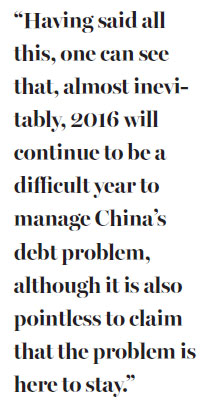Chinese economy is not in debtors' prison
Updated: 2016-04-29 08:25
By Ed Zhang(China Daily Europe)
|
|||||||||
It looks like another tough year for managing corporate indebtedness, but reforms and other measures offer a way forward
All the concerns about China's economy boil down to one question. That is how much debt, or indebtedness, it can manage, now that, according to a recent Bloomberg report, the economy's overall indebtedness was 246.8 percent of its GDP in 2015, higher than 2008 by 80 percentage points.
The early 2010s was a gloomy period. Deteriorating more rapidly than the country's GDP growth was the financial health of many companies. Indeed, other than household debt, which had a very low starting point, corporate debt saw the largest increase from 2008 to 2015, by more than 60 percentage points.
What overall data don't reveal, however, is how much of that corporate debt was incurred by companies siding with local governments' shaky, if not shady, investment plans, which don't easily generate sound returns, and how much of it is owned by companies destroyed or crippled by mismanagement on the policy level.

A not inconsiderable number of small and medium-sized enterprises (mostly privately owned) may have died miserable deaths due to policies inconsistent with market forces.
The boss of a meat-processing company in Beijing complained that, in a time of food inflation after the 2008 financial crisis, the government used to forbid companies like hers from raising product prices even when they had to spend a lot more at the slaughterhouse. The profitless company was unable to pay back its bank loans and now exists no more.
Her story illustrates the vulnerability of SMEs to not just changes in market conditions, but also government policies that fail to respond to the changes.
Financial conditions can be equally disappointing in some large state-owned companies, especially those no longer competitive because of their outdated technology and the burden of paying for the benefits of their large and aging workforce.
At times, the disease also affects companies with a technological edge that might help them become industry leaders. The boss of a privately owned producer of machine parts in Wuxi, an industrial town in southern Jiangsu province, reported that he hasn't seen any return from his new factory to supply quality steel pipes for nuclear power stations for two years because of the government's across-the-board ban on the development of such projects after Japan's Fukushima nuclear disaster in 2011.
With many cases like those cited above, one can imagine that even though data showed some new growth in the first quarter of the year, debt has still kept rolling over in many Chinese companies from several years ago. Growth, for them, is like a ballet performed in shackles.
In the end, Chinese banks will have to face the shadow from all this buildup of corporate debt at a time when companies have difficulty selling all their inventory.

The financial map of China shows, as banking specialists report, a more rapid rise in nonperforming loans (loans that may not be repaid) in the country's central and western regions than its city clusters in the Yangtze River Delta, the Pearl River Delta, and Bohai Bay. The weaker and smaller that companies are, the more easily they tend to be dragged down by debt.
The problem of China's mounting corporate debt won't easily go away even when some of the zombie companies among the SOEs get liquidated - if the government musters the political will. Those companies can't be of a large number. Their debt is only a small portion of all corporate debt.
The danger, for which the central government and the central monetary authority must be prepared, is perhaps that at a certain point in the economy's transition, some extraordinary measures will be needed to cut the general debt level of the companies that are still able to generate new income.
The proposed debt-equity swap is the first plan of this kind, as a design for large companies, although economists warn that the swap can't be used as only another round of bailouts for the companies that have practically lost their core competence and won't ever be able to compete in the real market.
Only companies that have reformed their management and shed their redundant work force are eligible for the swap, they say.
What may be done more easily for the small companies is to have a general tax cut, as the government is apparently doing, even though it still may take some time for the benefit of the tax cut to be borne out.
Having said all this, one can see that, almost inevitably, 2016 will continue to be a difficult year to manage China's debt problem, although it is also pointless to claim that the problem is here to stay.
The author is editor-at-large of China Daily. Contact the writer at edzhang@chinadaily.com.cn
Today's Top News
Inspectors to cover all of military
Britons embrace 'Super Thursday' elections
Campaign spreads Chinese cooking in the UK
Trump to aim all guns at Hillary Clinton
Labour set to take London after bitter campaign
Labour candidate favourite for London mayor
Fossil footprints bring dinosaurs to life
Buffett optimistic on China's economic transition
Hot Topics
Lunar probe , China growth forecasts, Emission rules get tougher, China seen through 'colored lens', International board,
Editor's Picks

|

|

|

|

|

|







